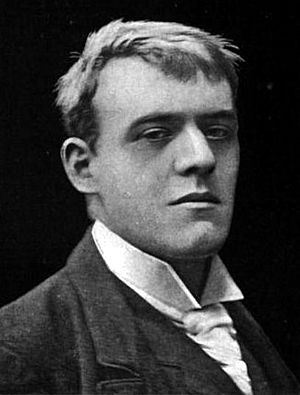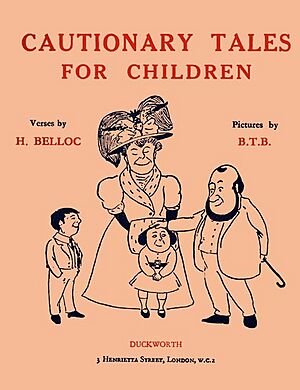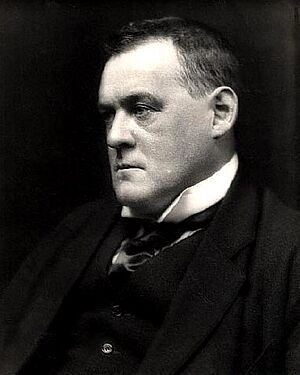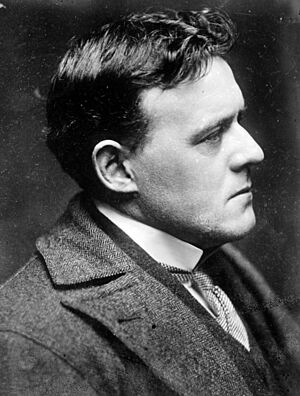Hilaire Belloc facts for kids
Quick facts for kids
Hilaire Belloc
|
|
|---|---|

Hilaire Belloc portrait by E. O. Hoppé, 1915
|
|
| Born | Joseph Hilaire Pierre René Belloc 27 July 1870 La Celle-Saint-Cloud, Seine-et-Oise, France |
| Died | 16 July 1953 (aged 82) Guildford, Surrey, England |
| Resting place | Shrine Church of Our Lady of Consolation and St Francis |
| Occupation |
|
| Citizenship |
|
| Alma mater | Balliol College, Oxford |
| Period | 1896–1953 |
| Genre | Poetry, history, essays, politics, economics, travel literature |
| Literary movement | Catholic literary revival |
| Spouse |
Elodie Hogan
(m. 1896; died 1914) |
| Children | 5 |
| Relatives |
|
| Signature | |
 |
|
Joseph Hilaire Pierre René Belloc (born July 27, 1870 – died July 16, 1953) was a famous writer and historian from France and England. He lived in the early 1900s. Belloc was also a great speaker, a poet, a sailor, and a political activist. His strong Catholic faith influenced much of his writing.
Belloc became a British citizen in 1902 but kept his French citizenship too. While studying at Oxford, he was chosen as the President of the Oxford Union, which is a debating club. From 1906 to 1910, he was one of the few openly Catholic members of the British Parliament.
Belloc was known for his strong opinions and debates. He was also a close friend of G. K. Chesterton. Another friend, George Bernard Shaw, called them the "Chesterbelloc" because they were often together.
Belloc wrote religious poems and funny poems for children. His popular book, Cautionary Tales for Children, included stories like "Jim, who ran away from his nurse, and was eaten by a lion." He also wrote history books and many travel stories, such as The Path to Rome (1902).
Contents
About Hilaire Belloc's Life
His Family and Early Life
Hilaire Belloc was born in La Celle-Saint-Cloud, France. His father was French, and his mother was English. His sister, Marie Adelaide Belloc Lowndes, also became a writer.
Belloc's mother, Bessie Rayner Parkes, was a writer and activist. She worked for women's equality. She helped start the English Woman's Journal. When Belloc grew up, he campaigned against women getting the right to vote.
His mother's father was Joseph Parkes. His grandmother, Elizabeth Rayner Priestley, was born in the United States. She was the granddaughter of Joseph Priestley.
In 1867, Bessie Rayner Parkes married Louis Belloc. Louis died in 1872, and his family lost all their money. His young wife then brought her children back to England. Belloc grew up in England, mostly in Slindon, Sussex. He wrote about his home in poems like "West Sussex Drinking Song." He went to The Oratory School in Birmingham.
His Marriage and Family
In 1889, Belloc's sister Marie met Mrs. Ellen Hogan, a Catholic widow from California. Mrs. Hogan had two daughters, Elizabeth and Elodie. Marie and her mother, Bessie, became good friends with the Hogans.
The next year, Belloc met Elodie Hogan for the first time and immediately liked her. Elodie's mother wanted her to become a nun, and Belloc's mother thought he was too young to marry. This made their relationship difficult.
Belloc was very determined. He sold almost everything he owned to travel to New York in 1891. He then walked a long way, about 2,870 miles, from Philadelphia to San Francisco to see Elodie. He paid for places to stay by drawing pictures and reciting poems.
When he arrived, Elodie's mother still did not approve of their marriage. Belloc was very sad and returned home. He then served in the French army for a year to keep his French citizenship.
While he was in France, Elodie's mother died. But Elodie was still unsure about marrying him. Belloc went to Balliol College, Oxford, in 1893. He loved Oxford and later wrote a poem about it:
Balliol made me, Balliol fed me,
Whatever I had she gave me again;
And the best of Balliol loved and led me,
God be with you, Balliol men.
At Oxford, he was chosen as President of the Oxford Union, the university's debating club. He also walked 55 miles from Oxford to London in only 11 and a half hours, which was a record! He graduated in 1895 with a top history degree.
In 1896, Belloc traveled to California again. He found Elodie very ill. After she recovered, they finally got married on June 15, 1896. They had five children.
In 1906, Belloc bought a house called King's Land in Shipley, England. Elodie died in 1914, likely from cancer, when she was only 45. Belloc was 43 and lived for over 40 more years. He wore black clothes for the rest of his life and kept her room just as she had left it.
Five years later, in 1918, his son Louis was killed in northern France while serving in the Royal Flying Corps. Belloc placed a memorial for him at the Cambrai Cathedral.
Later Years and Death
On April 2, 1941, Belloc's son Peter died at age 36 from pneumonia. He was serving in the Royal Marines in Scotland. He is buried in West Grinstead.
In 1937, Belloc gave lectures at Fordham University in New York City. He found the experience very tiring.
In 1941, Belloc had a stroke and never fully recovered. He also had burns after falling into his fireplace. He died on July 16, 1953, in Guildford, Surrey.
Belloc was buried at the Shrine Church of Our Lady of Consolation and St Francis in West Grinstead. He had regularly attended church there. At his funeral, Monsignor Ronald Knox said, "No man of his time fought so hard for the good things."
His Political Life
Belloc became a British citizen and then entered politics. He was disappointed when he didn't get a special fellowship at All Souls College, Oxford, in 1895. Some say this might have been because he put a small statue of the Virgin Mary on the table during his interview.
From 1906 to 1910, Belloc was a Liberal Party Member of Parliament for Salford South. During one speech, someone in the crowd asked if he was a "papist" (a term for a Catholic). The crowd cheered, and Belloc won the election, even though he was Catholic. He kept his seat in the 1910 election but did not run again later that year.
After his time in Parliament, Belloc's only steady job was as editor of Land and Water from 1914 to 1920. Otherwise, he earned money by writing and often struggled financially.
His Hobbies
In his later years, Belloc loved to sail when he could afford it. He became a well-known yachtsman and won many races. He was even on the French sailing team.
In the early 1930s, he was given an old boat called Jersey. He sailed it around the coasts of England with younger helpers. One sailor, Dermod MacCarthy, wrote a book about their trips called Sailing with Mr Belloc.
Hilaire Belloc's Writing
Belloc wrote over 150 books about many different topics, from war to poetry. He was considered one of the four most important writers of his time, along with H. G. Wells, George Bernard Shaw, and G. K. Chesterton. They often debated each other. Belloc worked closely with Chesterton, and Shaw called their partnership "Chesterbelloc."
When asked why he wrote so much, Belloc joked, "Because my children are howling for pearls and caviar." He believed that good writing should be clear and simple, like the children's rhyme "Mary had a little lamb."
Essays and Travel Books
In 1902, Belloc published The Path to Rome. This book describes his journey walking from Central France across the Alps to Rome. It includes stories about the people and places he saw, his own drawings, and lots of humor and poetry. In 1909, he wrote The Pyrenees, which gave many details about that mountain region.
He was a popular essay writer, part of a small group that included Chesterton and others.
His Poetry
His Cautionary Tales for Children are his most famous poems. They are funny poems with silly morals, and they were illustrated by Basil T. Blackwood and later by Edward Gorey. Even though they are for children, adults often enjoy their clever and sometimes dark humor. For example, "Henry King, Who chewed bits of string and was early cut off in dreadful agonies." Another poem is about "Matilda, who told lies and was burned to death."
The story of "Matilda who told lies" was even turned into a play called Matilda Liar! by Debbie Isitt. The famous illustrator Quentin Blake said Belloc was like a strict adult and a mischievous child at the same time. The author Roald Dahl was a fan of Belloc's work.
Belloc also wrote more serious poems in his book Sonnets and Verse. His poetry often had religious or romantic themes. In The Path to Rome, he often burst into spontaneous songs.
History and Politics
Three of his well-known non-fiction books are The Servile State (1912), Europe and Faith (1920), and The Jews (1922).
From a young age, Belloc knew Cardinal Henry Edward Manning. Manning once told him, "All human conflict is ultimately theological." Belloc understood this to mean that all major disagreements and struggles between people come from different beliefs about right and wrong or deep spiritual ideas. Belloc believed that people always think their own beliefs should be the foundation for everyone.
Belloc was a strong critic of both capitalism (where private businesses own everything) and many parts of socialism (where the government controls everything). With other writers like G. K. Chesterton, he supported an idea called distributism. This idea suggests that property and wealth should be spread out among many people, not just a few. Belloc argued that distributism was a return to how economics worked in Europe when it was mostly Catholic.
He also wrote many biographies of historical figures like Oliver Cromwell, James II, and Napoleon. These books showed his strong Catholic beliefs and his criticisms of the modern world.
Belloc also wrote many military history books. He even contributed to a book called If It Had Happened Otherwise (1931), which explored what might have happened if historical events had turned out differently.
His Religious Views
One of Belloc's most famous sayings was "the faith is Europe and Europe is the faith." He wrote about these ideas in many of his books. These writings are still used today to explain Catholic beliefs.
When he was young, Belloc moved away from Catholicism. However, he later said that a special spiritual event, which he never talked about much, brought him back to his faith. He mentions this event in his book The Cruise of the Nona.
Belloc believed that the Catholic Church gave people a spiritual home. He also famously said, "Wherever the Catholic sun does shine, there's always laughter and good red wine," showing his love for Catholic culture.
He had strong opinions about other religions. For example, he used harsh words to describe heretics (people who hold beliefs different from official church teachings).
His Love for Sussex
Belloc grew up in Slindon and lived most of his life in West Sussex. He always wrote about Sussex as if it were the most beautiful part of England. He loved Sussex because it was his childhood home and felt like his "spiritual home."
Belloc wrote several books and poems about Sussex, including Ha'nacker Mill, The South Country, and the travel guide Sussex (1906). One of his best-known works about Sussex is The Four Men: a Farrago (1911). In this book, four characters, who represent different parts of Belloc's personality, travel across the county.
Belloc also loved Sussex songs and wrote lyrics for some of them. People in Sussex celebrate Belloc Night every year on his birthday, July 27. It's like Burns Night in Scotland. During this celebration, people read from Belloc's works and enjoy a supper of bread, cheese, and pickles.
Hilaire Belloc in Media
- Stephen Fry has recorded an audio collection of Belloc's children's poetry.
- The composer Peter Warlock set many of Belloc's poems to music.
- Peter Ustinov recorded Belloc's The Cautionary Tales in 1968.
- A famous parody of Belloc, meant as a tribute, is Mr. Belloc's Fancy by Sir John Squire.
- Syd Barrett used Cautionary Tales for his song "Matilda Mother" from the 1967 album The Piper at the Gates of Dawn.
- King's Mill, Shipley, which Belloc once owned, was used in the British TV show Jonathan Creek.
- In an episode of Monty Python's Flying Circus, Hilaire Belloc was humorously listed as one of the famous people who were secretly mice.
See also
 In Spanish: Hilaire Belloc para niños
In Spanish: Hilaire Belloc para niños
- Hilaire Belloc bibliography
- Mr. Belloc Objects to "The Outline of History" – H.G.Wells' dispute with Belloc
- Hilaire Belloc – Wikiquote
Images for kids






